New Hampshire has many wildlife habitats on land and sea, which offer a home to many wild animals. About 85% of the state is covered by forests, with one of the most famous trails in the world, the Appalachian Trail running through the state’s mountains. Are you wondering what kind of wildlife can be found in New Hampshire? In this article, we enlighten you on different New Hampshire wildlife you can find in our beautiful state.
Wildlife of New Hampshire
The hills, lakes, rivers, forests, and coastline offer habitats to many animals in New Hampshire. There are more than 500 native animal species in this state. The most common animals are the northeastern woodland animals, while other wildlife includes marine mammals and shorebirds.
Small Mammals in New Hampshire
The hills and forests of New Hampshire are home to many small wild mammals. While hiking in these hills, it will be easy to spot southern bog lemmings, American martens, northern bog lemmings, smoky shrews and snowshoe hares. The most common small wild mammals are raccoons, opossums, and skunks, while the strangest animals are southern flying squirrels, porcupines and fisher cat.
A fisher cat, also known as a fisher, is a New Hampshire animal that has a long slender body with muscular short legs that are similar to those of a weasel. These body features make it a great climber, very agile and fast. Hunting had driven fishers to extinction, but they are now found all over the state.
In the lakes, New Hampshire mammals include muskrats, weasels, river otters and beavers. White-footed mice, woodchucks, woodland jumping mice and groundhogs are some of the rodents found in New Hampshire. The state is also home to some rarest native bat species such as silver-haired bat, small-footed bat, and long-eared bat.
Larger Mammals in New Hampshire
There are some larger mammals that can be found in New Hampshire and here are some of the most common.
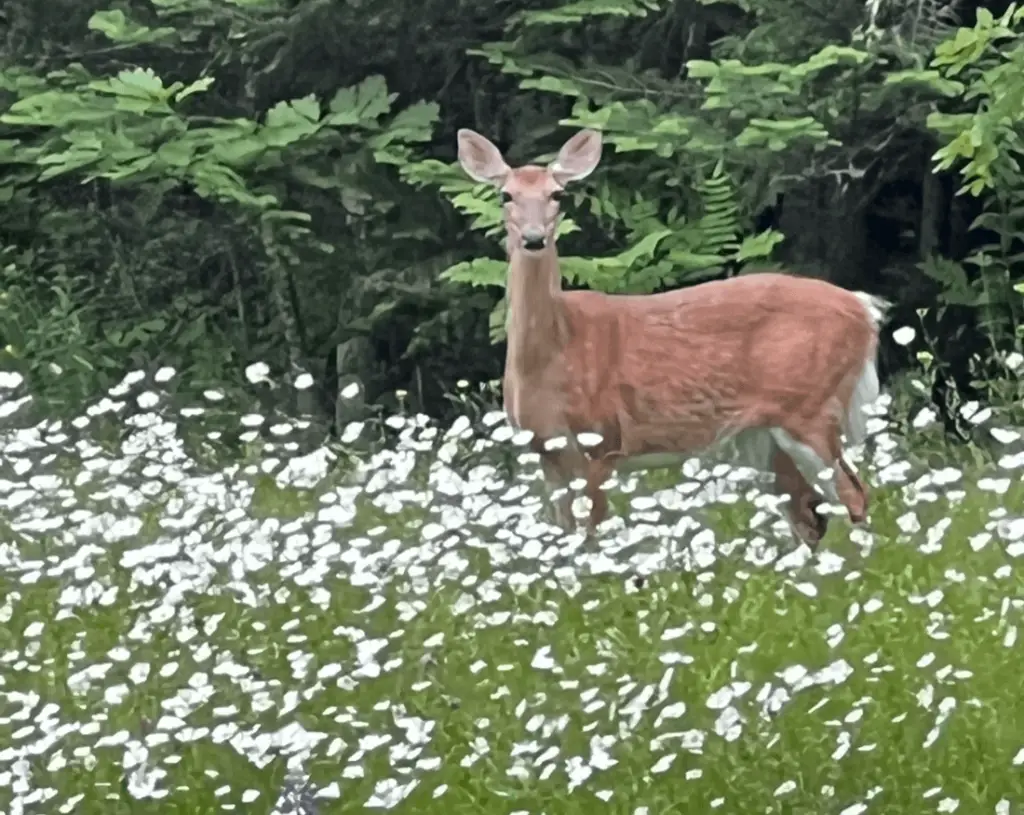
White Tail Deer
I have always loved White Tail Deer and enjoyed every time I see them in New Hampshire. I grew up in Enfield NH in the Upper Valley and there were always plenty of White Tail Deer in that area of the state. According the NH Fish and Game, there are over 100,000 White Tail Deer in the state.
I have often seen White Tail Deer in fields at dusk or dawn as that is when they tend to be most active. If you are driving around New Hampshire at these times of day it is always a good idea to keep your eyes focused on the road and side of the road. There are on average 1,200 White Tail Deer collisions every year in New Hampshire so be careful out there.
Eastern Coyotes
Does NH have Coyotes? Yes, New Hampshire has Eastern Coyotes that live in the state. Eastern Coyotes have been seen in the state since 1944 and are commonly seen in almost every county in NH. My brother lived in Canaan NH and one Summer night we were having a camp fire in his back yard and we could hear Coyotes howling in the back words.
Coyotes are social pack animals and eat small wildlife creatures and whatever else they can find. I have had friends in NH that keep livestock (chickens, etc) and they have shared that Coyotes have eaten the majority of their livestock once they have discovered this easy prey. Most of the time you are very unlikely to see Coyotes in New Hampshire. The only times that I have seen them is at night driving and they dart across the road disappearing as quickly as they appeared.
Moose
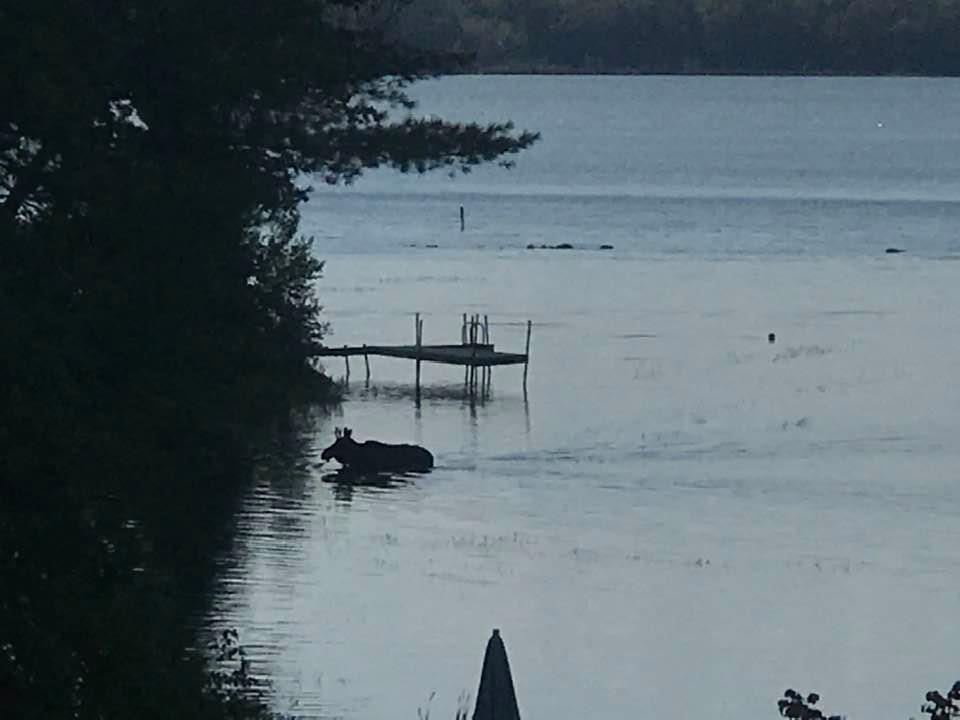
Moose are large, majestic animals that inhabit New Hampshire. They are a rare sight, most usually seen in the Northern-most territories in NH such as the famed Moose Alley in Pittsburg NH. At last count of the New Hampshire Fish and Game, there are roughly a few thousand Moose living in the state.
Moose have an impressive stature and can weigh between 600 to 1,600 pounds and stand over 6 feet in height. The Male Bull Moose can have large antlers and the female Cow Moose have a notable white fur patch under their tail.

While Moose are massive animals they can move surprisingly-quickly even through thick brush. They can run as fast as 35 miles an hour. Years ago I was driving through Pittsburg NH on the way back home from a camping trip and I had a large Moose trotting beside my vehicle! It was impressive a pretty crazy experience!
Additionally, they are great swimmers and can swim through ponds, rivers, and lakes with ease. The picture above is one my parents took of a Moose swimming through a channel on Crystal Lake in New Hampshire.
Moose are herbivores and eat about 25-45 pounds of vegetation to fill their bellies. Impressive right!
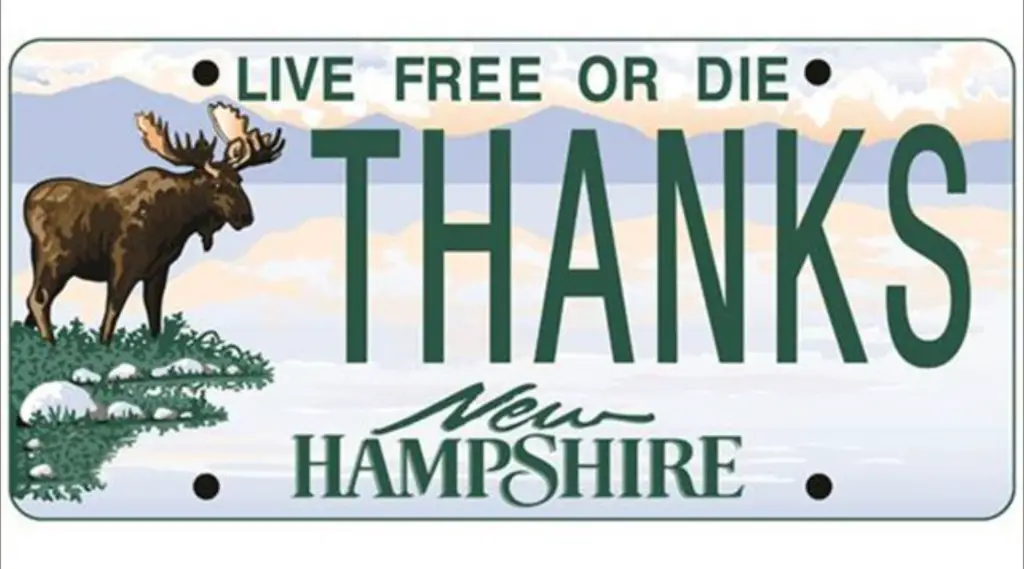
Moose are such a popular animal in the State of New Hampshire we even put them on special license plates. If a NH resident invests in one of the special license plates for the vehicle a portion of the proceeds go towards conservation of New Hampshire wildlife. You can learn more about the Moose Plates program here: https://www.mooseplate.com/
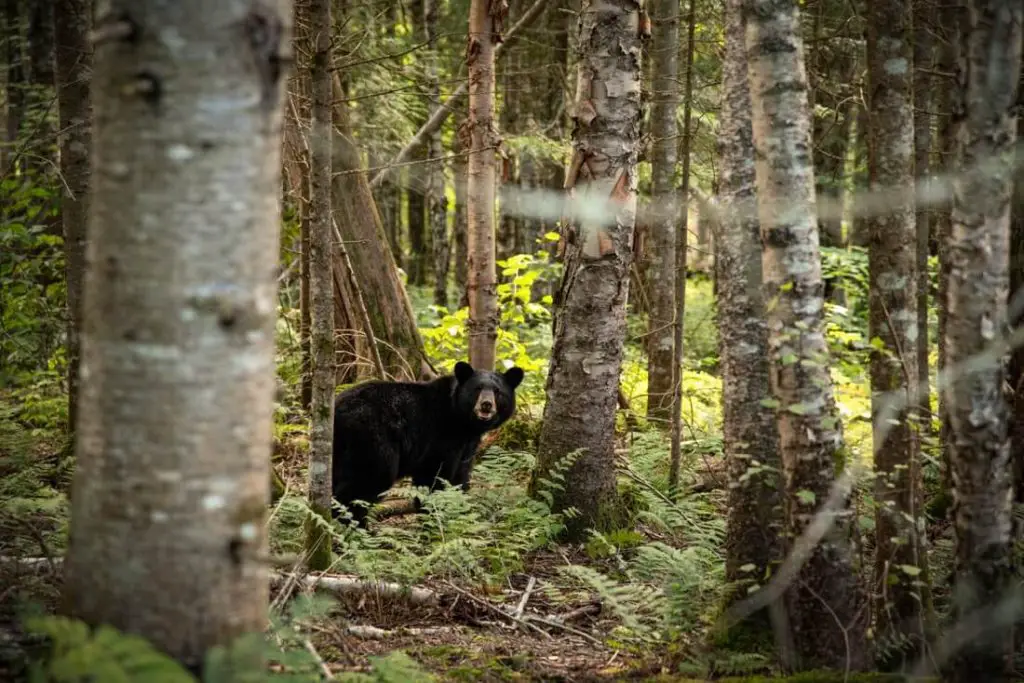
Black Bear
New Hampshire does have Black bears and I have seen these beautiful animals occasionally throughout the state. They tend to be fearful of humans and are typically rare to see in nature. Black Bear females can weigh in as much as 150 pounds while the male black bears can weigh as much as 250 pounds!
While Black Bears in NH tend to avoid humans, I have seen them walking through back yards and seen photos and videos of them cracking open a bird feeder to get at some Suet. NH Black Bear experts recommend that NH residents take down bird feeders and secure their garbage especially between the April and December (when black bears in NH are most active).
Doing so can help prevent damage to your property and prevent bears from becoming used to eating human food. When black bears get used to eating human food and feel comfortable around humans that is when problems typically happen.
Here is a short video of a Black Bear cub near the dam at Crystal Lake in Enfield NH.
Fish In New Hampshire
Most fish species in New Hampshire can be found in the North Atlantic cold waters. Some of the marine fish found in New Hampshire include several species of flounder, such as witch flounder, smooth flounder and white flounder, with some of the most common fish being striped bass, Atlantic cod and blue fish.
Coho salmon, Chinook salmon, shad, Smet, Atlantic sturgeon and herring are common fish species. Shellfish is famous in New England, and mollusks in New Hampshire include oysters and soft shell clams. Pilot whales, harbor seals, dolphins and porpoises are some of the marine mammals found in New Hampshire. There are Deep Sea fishing charters on the Seacoast of NH if you are up for the challenge!
In the lakes and rivers in New Hampshire you can find popular freshwater fish such as bluegills, carp, lake trout, largemouth bass, brown bullheads, rainbow trout, sunfish, brook trout, shiner, lamprey and whitefish. The rivers and lakes provide amazing spots for sports fishermen. My personal favorite is catching brook trout and my family and I would venture to Pittsburg NH at the Second Dartmouth College Grant to fish the Little Dead for these delicious fish.
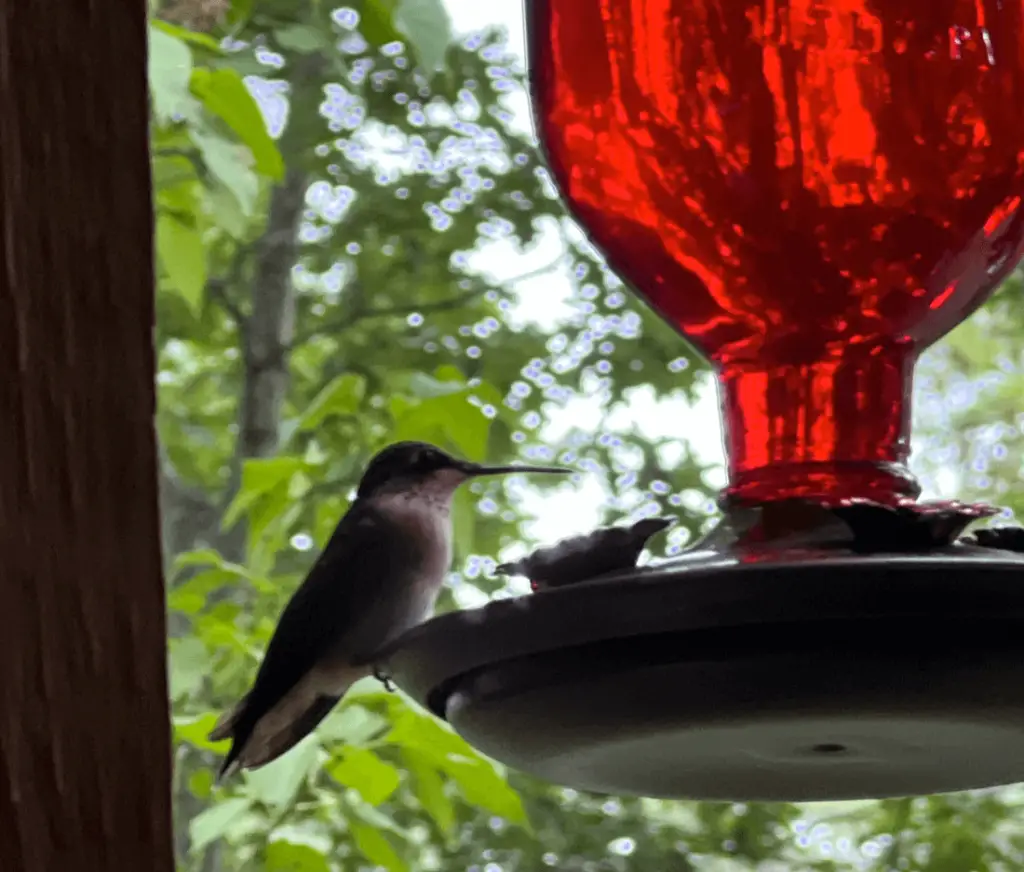
Birds In New Hampshire
Wildlife in New Hampshire includes hundreds of bird species. They include shore birds, forest birds and waterfowl. The 18-mile New Hampshire shoreline and lakes are home to birds such as loons, mallards, great blue herons, piping plovers, snowy egrets and black-headed gulls.
Common forest bird species are indigo bunting, hermit thrush, dark-eyed junco, eastern bluebird, snow bunting, grey catbird, ruby-crowned kinglet and mourning dove. Many owl species, including golden eagles and rough-legged hawks, make up the raptor species. Of course, there is the state bird if NH the Purple Finch too!
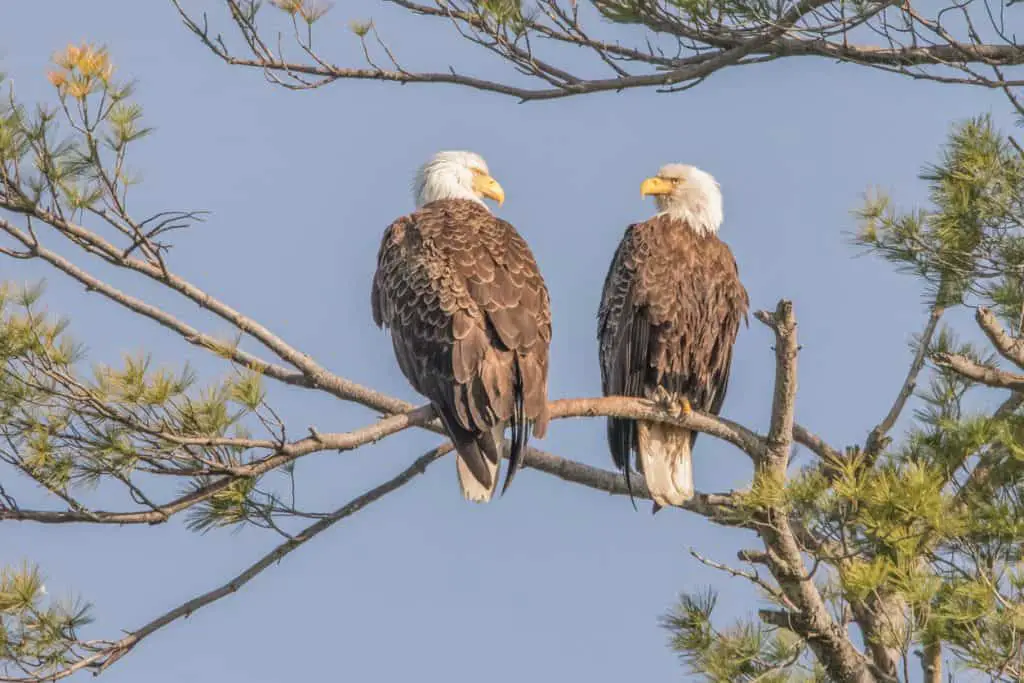
Bald Eagle
There are Bald Eagles in New Hampshire and I have personally seen them on in Concord NH and at Crystal Lake in Enfield NH fishing in the lake and flying overhead in different parts of the state. They have a rescued Bald Eagle that lives at the NH Audubon wildlife conservation center in Concord NH if you want to see one of these magnificent birds up close.
American Woodcock
The American Woodcock is a small brown bird that can be found in New Hampshire. Due to their natural camouflage they can be tough to spot in thick NH brush.
Loons
Loons are one of my favorite NH birds to watch. Loons nest in the various lake and ponds in New Hampshire and I often see them at the small lake my parents live on in Enfield NH (Crystal Lake). Loons are a threatened species here in NH and are protected from hunting by NH state and even federal laws. During the Winter months loons that call NH home in the warmer months migrate to the coast of the Atlantic ocean. You can learn more about NH loons and learn about the preservation efforts at http://www.loon.org/
Eastern Wild Turkey
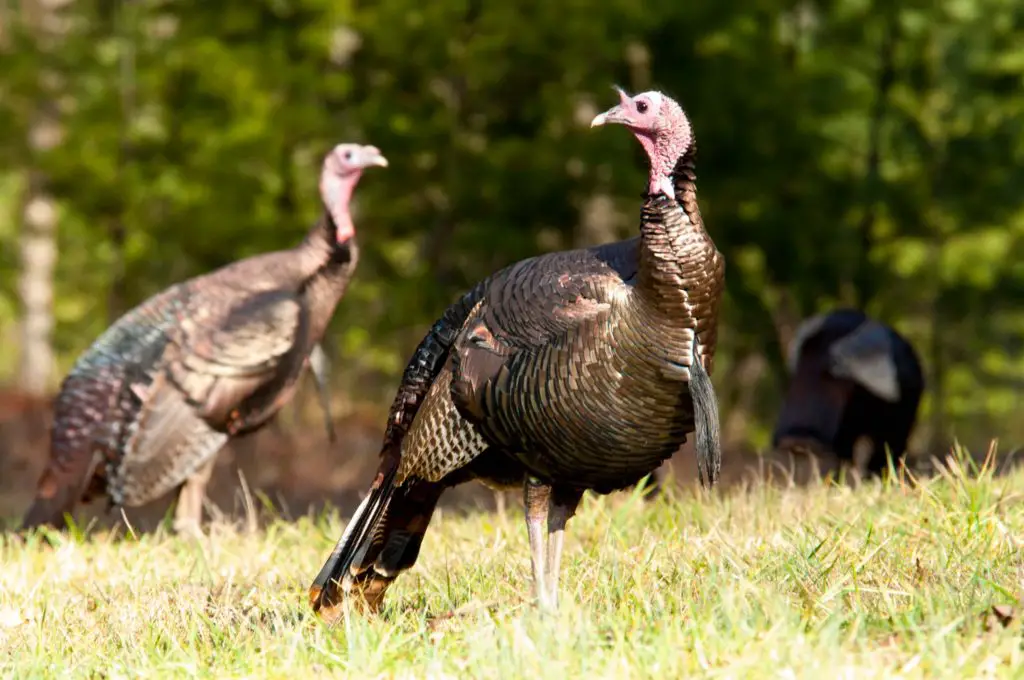
A fairly common animal you will see roaming around the road sides and fields of New Hampshire is the Eastern Wild Turkey. The male turkeys (known as Toms) can weigh in 18-24 pounds and the female turkeys can weigh in at 10 pounds. It is not uncommon to be driving down the road and have to stop as a group of Turkeys slowly cross the road in front of you.

Owls
New Hampshire is home to eleven species of owls some of which live here year-round while others are here seasonally. Some common owls you may see if you have a keen eye included Barred Owls, Boreal Owls, Eastern Screech Owls, Great Horned Owls, Long ears Owls, Northern Saw-Whet Owls, Short Eared Owls, Snowy Owls, Northern Hawk Owls, Great Gray Owls, and even Barn Owls.
Owls are typically difficult to see in New Hampshire because they are well-camouflaged and when the thick forests have all the leaves on the trees it makes them difficult to spot. I have been more likely to see Owls in a tree in the Spring before the leaves fully fill out or in the Fall after the leaves have fallen off the tree.
I have also visited the NH Audubon and they have some Owls in captivity so you can see these beautiful creatures up close!
Reptiles and Amphibians in New Hampshire
Frogs and other species of amphibians are also included in New Hampshire animals . You will find the northern leopard frog, grey treefrog, and mudpuppy in the woods. The famous north eastern frog, the spring peeper, is known for its strange and melodious announcements of the coming spring.
Spotted salamander, spring salamander and marbled salamander are some of the 10 species of salamanders among New Hampshire wild animals.
Turtles In New Hampshire
There are 7 native species of turtles here in New Hampshire. Common turtle species in New Hampshire include snapping turtles, spotted turtles, Eastern Box turtles, Common Musk turtles, Wood turtles, Eastern Painted turtles, and Blanding’s Turtle.
Snapping Turtles
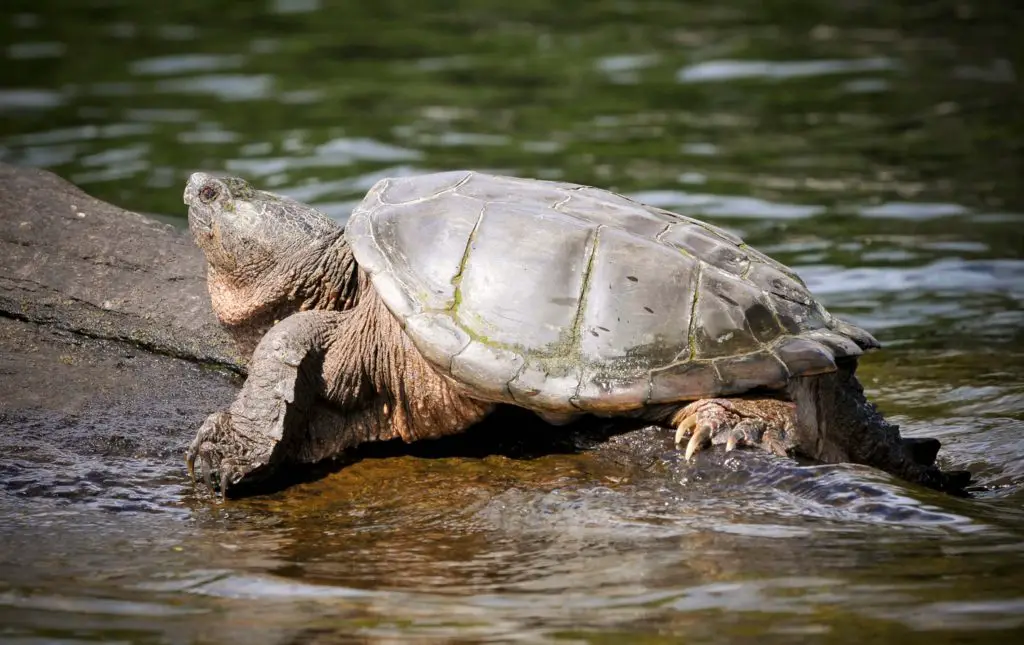
I’ll never forget the first time I saw a NH Snapping Turtle. I was a young boy and my Dad and I were driving down the road and we stopped in the middle of a back road because there was a massive Snapping turtle slowly sauntering across the road. We got out of the truck and went up and looked at this massive, almost pre-historic looking beast. It was an impressive sight!!
Snapping turtles in New Hampshire can measure 8-14 inches and weigh as much as 70 pounds!! The head of a NH snapping turtle can be quite large and they have a very powerful jaw. A word of advice…don’t put your hands or fingers anywhere near their mouth. They have the name of snapping turtle for a reason!!
Snakes In New Hampshire
New Hampshire is home to 11 native snake species such as redbelly snakes, common garter snakes, and rattlesnakes. The redbelly snake is about 10 inches and has a black body and bright red belly. It has a very rare coloring of any snake. It is nonvenomous, feeds on earthworms and slugs, and is harmless to people.
What is The Official Animal of New Hampshire
The white-tail deer is a common deer that frequently visit parks in New Hampshire. It is the state’s official animal.
The ladybug is New Hampshire’s official insect. Also known as lady beetle or ladybirds in other countries using English as their first language, it is a very loved bug in many parts of the world and in many cultures, it is a sign of good luck.
The purple finch is the state’s official bird. It is a beautiful bird with a bright purple shade on its berry-colored feathers.
Where to Find Wild Animals In New Hampshire
You can find New Hampshire wild animals in the following areas.
Northwood Meadows State Park
It is a forested park with vast wetlands that are ideal for picnicking. It has waterfalls and creeks offering fantastic sceneries for nature walks.
Bear Brook State Park
This park is great for watching birds, small mammals, raptors and white-tail deer. The park has ponds where you can find frogs, beavers and birds.
Ahern State Park
It is a protected area found on Lake Winnisquam shore. Here you can see birds, crabs, ducks and small wild animals, and it also has beautiful forested trails great for nature walks.
Seacoast Science Center
It is located in Odiorne. This is a great place to learn about marine animals hands-on.
Zoos and Wildlife Education Centers in New Hampshire
You find animals that live in New Hampshire in zoos and education centers such as;
Squam Lake Natural Science Center
It is a zoo and a wilderness education center that boasts scenic views featuring hiking trails, lake cruises, live animals and a large lake. In this lake, you will find loons and various shorebirds species. The zoo is home to rescued wild animals that cannot be taken back to the wild.
While on the walking trails, you are likely to spot all animals. You will find bobcats, grey foxes, fishers, coyotes and small rodents. The birds include raptors and shore birds, while the amphibians include turtles and frogs.
New Hampshire Audubon
This is a wildlife education center and a sanctuary with programs that protect species such as bald eagles and peregrine falcons. Education programs provide knowledge about conservation for the youth and adults. The sanctuary protects several species of rare plants and animals.
Dangerous Animals in New Hampshire
Moose
They are large, sturdy and strong animals. They are gentle and peaceful while in their natural habitat. However, when bothered by humans or other animals, they can get very aggressive. A typical situation is when a Cow has her young with her and humans get too close to take photos. The mother Moose doesn’t appreciate this, will typicall put their ears down, and can charge. Moose in New Hampshire can weight between 600 – 1600 pounds so it is not an animal you want charging you.
Beyond that, many car accidents happen in New Hampshire due to people driving too fast and hitting a Moose with their car. Many people and Moose die every year due to these type of accidents so if you are planning on visiting Moose Alley in New Hampshire or anywhere in Northern NH be sure to drive safely and ‘brake for Moose’ as the signs say. It could save your life and the the life of the Moose.
Black Bears
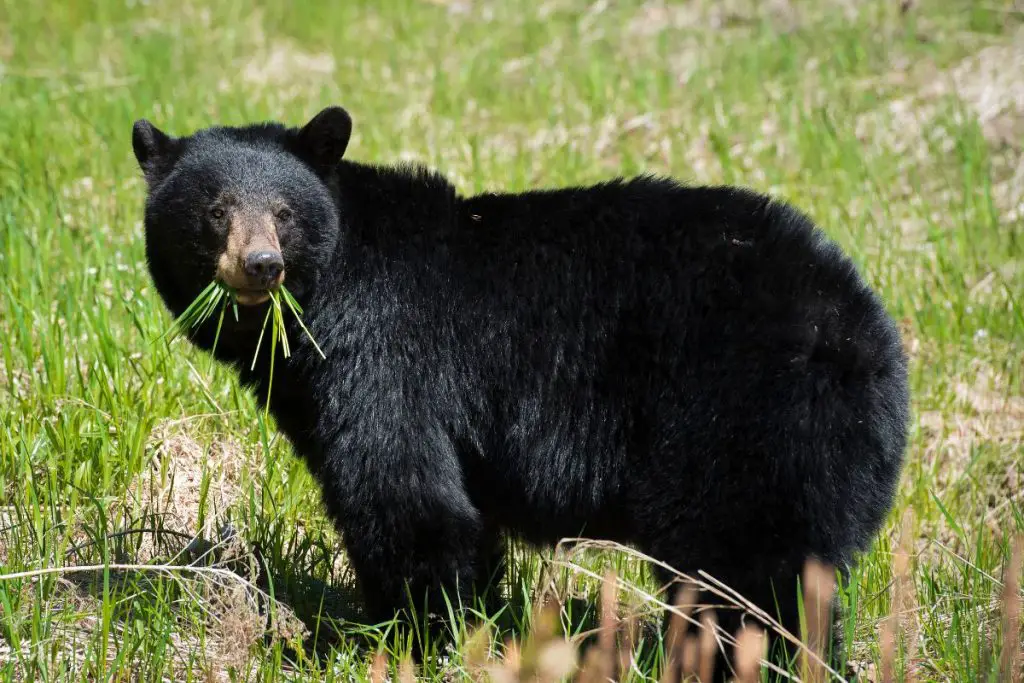
A black bear is a medium-sized bear species inhabiting New Hampshire’s forests. They are primarily solitary and nocturnal hunters. Black bears have a peaceful relationship with humans but can get aggressive when threatened.
Ticks – The Most Dangerous Animal in New Hampshire
The wood tick is the most dangerous New Hampshire state animal. While these animals might not come to mind as the most dangerous animal, over the years they have caused much damage and many illnesses. It is a blood-sucking parasite that carries many diseases. Some of the diseases these creepy creatures can carry are Lyme disease, Anaplasmosis, Powassan virus, Borrelia miyamotoi, and Babesiosis.
According to the New Hampshire Department of Health and Human Services, “476,000 people may get Lyme disease each year in the United States” and it is definitely something to be aware of here in New Hampshire as well.
I know many people who have Lyme disease due to ticks and the long-lasting health issues that this disease can cause are scary. If you are going to be spending time in the thick woods of New Hampshire it is important to be aware of ticks and take precautions to protect against them.
Endangered Animals In New Hampshire
Some of the endangered New Hampshire wild animals include;
Marbled Salamander
This salamander is black and white striped and grows to almost 4 inches, and you can find it in rocky slopes and forests. The state has considered this species as one in dire need of conservation.
Piping Plover
It is a rare shorebird, one that is protected by state law. The bird is grey and white and nests on sandflats, barrier islands and coastal beaches.
New England Cottontail
Once very widespread in New England, the large native rabbit is now considered endangered. Landowners in New Hampshire and surrounding New England states are encouraged to create habitats friendly for cottontails. New England cottontail and other species are protected in the Great Thicket National Wildlife Refuge conservation area.
Canada Lynx
This is a shy, secretive and a rare big cat that hunt snowhoe hares. They were common in northeastern states, but people have spotted them in Vermont and New Hampshire in recent years.
Moose

They were once found all over New Hampshire. However, in the past few decades, their numbers have declined, and wood ticks are to blame. Many moose have died from fatal anemia caused by the ticks. There have been reported cases where a single Moose had over 30,000 ticks on the poor animal.
FAQs About New Hampshire Wildlife
Are there wolves in New Hampshire?
Wolves were eradicated in New Hampshire in the early 1800s.
Are there badgers in New Hampshire?
There are no badgers in New Hampshire. You can find them in the northern Great Lakes states in the U.S.
What is the top predator in New Hampshire?
The top predators found in New Hampshire are the black bears and moose. These large predators can get very aggressive when they are threatened.
Does New Hampshire have poisonous animals?
The timber rattlesnake is the only venomous snake found in New Hampshire. The snake is protected by law.
Are there Mountain lions in New Hampshire?
There have been many reports of mountain lion sightings in the state. However, the New Hampshire Fish and Game Department has no physical evidence of any mountain lion presence in the state.




